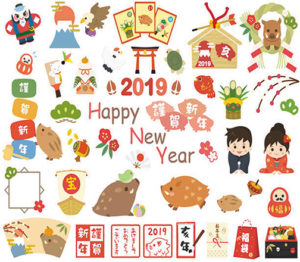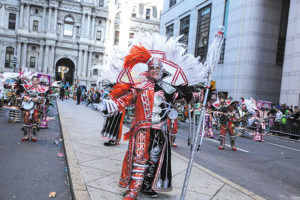 By Bobbie Sweeney
By Bobbie Sweeney New Year’s Day is a special day for everyone in the world. Most countries have observed the first day of the year as an important day for thousands of years. Although customs vary from nation to nation, and the time of year varies for different reasons, the meaning is the same to all. The beginning of a new year is a time for a fresh start.
People of the Christian faith celebrate the Feast of the Circumcision, and Catholics respect the day as a holy day of obligation. People of the Jewish faith celebrate the Day of Atonement, and the 10 holiest days of the year occur for them between Rosh Hashanah and Yom Kippur. Moslems celebrate the new year as the coming of the Prophet Mohammed, hundreds of years before.
In most countries, there is much preparation given to the arrival of the new year. The night before, New Year’s Eve, is always a gay, festive time for families and friends. But at the stroke of 12, the first day of the new year becomes a solemn, prayerful occasion. Visiting and exchanging small gifts is universal among all nations. The new year for many people of the world occurs on the 1st of January, in accordance with the Gregorian calendar. Those who celebrate at a different time use the solar calendar.
The Chinese used the ancient lunar calendar for thousands of years, until China adopted the Gregorian calendar. When the lunar calendar was in effect, the new year was celebrated at the time of the second new moon following the winter solstice. The winter solstice, in the Northern Hemisphere, is when the sun is farthest south of the equator. Then the new year started in late January or early February.
It is the Chinese custom to decorate with flowers that have special meaning. The white narcissus brings good fortune, the pink blossoms of the peach or plum trees mean long life, and peonies assure them of wealth and honor in the coming year. Any red flower is appropriate, because the Chinese believe red to be the color of good luck and happiness.
The Chinese celebrate everyone’s birthday on New Year’s Day. No matter when the real birthday occurred, a person is considered to be one year older on the first day of the year.
 Whether they live in Israel or in other countries, the Jewish people celebrate the new year in the autumn of each year, September or October. The day is called Rosh Hashanah, and it commemorates the traditional date for the creation of the world. It is a serious and solemn time for the Jewish people, unlike their other festivals, which are holidays and are celebrated with fun and frolic.
Whether they live in Israel or in other countries, the Jewish people celebrate the new year in the autumn of each year, September or October. The day is called Rosh Hashanah, and it commemorates the traditional date for the creation of the world. It is a serious and solemn time for the Jewish people, unlike their other festivals, which are holidays and are celebrated with fun and frolic. The Christians in Egypt celebrate the new year on the 1st of January, but the Moslems celebrate at a different time of the year, the middle of July. The Moslem New Year is a holy day. The day is determined by the appearance of the new moon according to the old Arab calendar, which has been in use for over a thousand years.
In South America, the people in Brazil and Bolivia celebrate on Jan. 1, much the same as North America. Brazil has a tradition of serving lentil soup or lentils with rice at the first meal of the new year, because lentils signify wealth.
The Indians in Bolivia do not celebrate in the modern fashion as the Spaniards do. They observe the new year at planting time. After the day’s planting is done, families gather at one of the fields and hold a solemn ceremony in honor of Mother Earth, who they believe to be the goddess of the fields and crops.
In Austria and Belgium, the first day of the year is recognized as a time for looking into the future; while in Germany, it is a day when they attempt to live as they would like to live the next 12 months of the year.
New Year’s Day in Iran is celebrated in the springtime. The first day of spring is March 21, according to the ancient Persian solar calendar, which they have used for thousands of years. Everyone enjoys the outdoors on that day. It is considered bad luck if anyone stays in the house.
When spring comes to Ethiopia in September, the new year begins. The Julian calendar has been followed by these people for hundreds of years. The new year arrives after the rainy season, when the grass is green and the yellow daffodils are in full bloom.
People living in the British Isles believe the manner in which they behave on this day is an example of how the rest of the days of the year will be spent. They make new year’s resolutions too, and fully expect them to be broken the next day or so.
The Scotch and Irish consider New Year’s Day an important holiday of the year. But to the English and Welsh, it is not that important, and they go about their work as usual.
The Scotch have a superstition that the “first foot” to enter the home on New Year’s Day determines their luck for the rest of the year. If the foot belongs to a dark-haired man, they will have good luck. If the man has red hair, they will have bad luck. The foot must never be that of a woman to enter first, or they will have very bad luck.
The Irish let their imagination run rampant, and claim that fairies are active the night before the new year, and they advise all good people to stay indoors, so that no mischief will befall them.
In the United States, we look forward to the celebration of New Year’s Eve. Families and friends gather together for parties in the home or in some night spot. At the stroke of 12, everyone toasts the new year with champagne and wish all a happy new year. Since television has come into our homes, and the fact that time changes across the nation, we can watch the first celebration in New York, and follow across the country for three hours to watch the celebration on the West Coast in California. New Year’s Day is a time for visiting friends and relatives, and wishing them luck and happiness in the coming year. It was not always a gala affair in America. The Pilgrims refused to celebrate this day, because they thought of it as a pagan custom. But when other people came to live here, things changed. The Dutch, who settled in New York, continued to enjoy the celebrations they had enjoyed as children in their homeland.
The Swedish colonists introduced the custom of dressing in fancy costumes and parading through the streets with masked faces. The English colonists introduced the actors known as “mummers,” who dressed in fancy clothing and went about acting in pantomime or silent plays. A combination of these two customs resulted in the famous Mummers’ Parade, which is held on New Year’s Day in Philadelphia.
It is a custom in the United States today to watch TV with friends while eating and drinking, and enjoying the gorgeous parades from California to New York and the seemingly endless parade of football games.
However the first day of the year is celebrated in any part of the world, the same greeting is imparted to all: a truly sincere wish for a happy and prosperous new year.















Follow Us